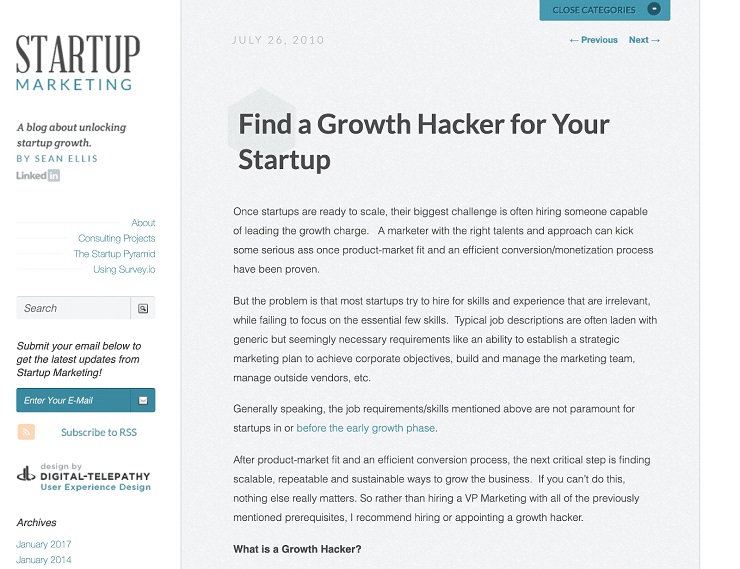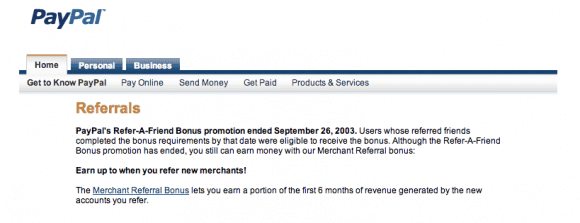In a world where 30-second Super Bowl ads cost $5 million and brands like Coca Cola spend $5.8 billion per year on advertising, how can small companies and startups possibly compete?
If you’re just starting a company or trying to gain traction, seeing numbers like that can make you feel like you’re armed with a BB gun while you’re competition is driving a tank.
The good news: There’s a way for smaller companies and startups to level the field and fight back. It’s called growth hacking, and it’s paved the way for modern, scrappy businesses to take down even the corporate titans of the past.
You’ve probably heard of this concept, but it can be kind of a fuzzy, overused term.
So to explain exactly what growth hacking is, and how you can use it to your business’s advantage, we recently invited our resident growth hacker Bronson Taylor into the Foundr studio.
As a serial entrepreneur, instructor of our Growth Hacking course, host of Growth Hacker TV, and the guy who literally wrote the ultimate guide to growth hacking, this guy is a master of the concept. He’s deployed growth hacking strategies to drive the kind of results that normally require millions in ad spend.
So if you don’t have $5 million to spend on a 30-second ad, pay close attention. Bronson’s growth hacking tactics can change the game for any business that needs outsized results—fast. Once you finish the video, keep reading for a recap and to see more examples of how you can use growth hacking to create an unfair advantage for your business.
EXCLUSIVE FREE TRAINING: Successful Founders Teach You How to Start and Grow an Online Business
What Exactly is Growth Hacking?
On July 26, 2010, marketing changed forever. On that day, Sean Ellis, founder and CEO of GrowthHackers, published a blog post titled “Find a Growth Hacker for Your Startup” that lit a fire in marketing departments around the world.
According to Taylor, the post drew a line in the sand, saying startups didn’t need marketers focused on logos, “branding” and design. They needed armies of people focused solely on one goal: growth.
Ellis wrote the piece after trying to hire people for his companies and running into the same issue time and time again. People had the skills to make things look pretty and sound nice.
But at the end of the day, those things didn’t matter to startups, particularly those in the early stages. Who cares how pretty your logo is or how good your website looks if nobody even knows you exist?
Instead, Ellis argued that what was critically important was people fixated on any and everything that led to growth. These growth hackers, as Ellis called them, didn’t have to be classically trained marketers.
A growth hacker could come from any background. They could work in any department in the company. The only thing they had to do was be focused on driving meaningful results for the business.
As Taylor points out, the key distinction was that these growth hackers didn’t care about the design of the website… unless the website’s design led to growth in the number of users, paying customers, or revenue in some way. They didn’t care about press or branding, unless these things contributed directly to the organization’s growth.
Taylor says, “This might seem like a minor shift in language, but it actually represented a tectonic shift in the way companies approached marketing and more.”
It forced companies and their teams to get incredibly efficient with their budgets and time. Because if an action or idea wouldn’t contribute to growth, it wasn’t done.
After Ellis wrote the piece, it spread like wildfire, because it voiced a deep frustration many startups and founders felt when they were hiring.
They didn’t need people who spent ad money like Coca Cola or Pepsi.
They needed people who were obsessive, curious, and analytical. They needed people who woke up and went to bed thinking about strategies related to growing the business. They needed growth hackers.
In the wake of his post, entire organizational structures were changed to serve bringing people like that onto teams. Today the term has become fairly mainstream, but it’s still a relatively new concept.
How Growth Hacking Works
Now that you know the origin of the term growth hacking and why it’s so important to startups today, you might be thinking, “OK I kind of get what it is, but how exactly does growth hacking work?”
Don’t worry. We got you fam.
As Taylor says, “Exactly how you practice growth hacking will be different for every company. But at the end of the day, it’s about getting creative with how you generate traffic. And then turning that traffic into customers.”
A great example of a growth hacking strategy in action is how Morning Brew used referrals to grow their email newsletter from 100,000 to over 1.5 million readers in 18 months.
Morning Brew could have tried to fight for subscribers one blog post at a time, which is how most newsletters grow. But the problem was, they were in a super competitive niche (finance) and creating content that ranks on Google takes a lot of time, if it ever pans out at all.
As a bootstrapped company, they didn’t have a ton of cash to sink into advertising either.
So they looked at their business through the lens of growth hacking and asked, “What’s the fastest, most cost effective way that we can grow our user base?”
The answer they came up was a massively successful referral program—where users could unlock fun rewards like free stickers, mugs, and shirts for simply sharing with their friends.
In fact, 420,000+ of their of 1.5 million subscribers could be traced back to word-of-mouth marketing and referrals. How’s that for growth?
The best part: They were able to turn an existing asset (current readers) into explosive growth. That’s an example of growth hacking at its finest.
It’s about asking tough questions and coming up with creative solutions that bring fast, outsized results using the same inputs.
EXCLUSIVE FREE TRAINING: Successful Founders Teach You How to Start and Grow an Online Business
Other Potential Growth Hacking Strategies
Morning Brew’s referral program is just one example of growth hacking in action. But there are tons of other ways that you can rapidly grow your users and customers.
As Taylor says, “The key to growth hacking is looking for strategies that allow you to put in a low-or-no cost input and achieve abnormally high rewards.”
For example, any of these techniques can be considered growth hacking (if you use them creatively):
- Launching a blog and creating valuable, shareable content. For example, the website Copyblogger famously started as a blog where Brian Clark would share valuable tips for bloggers. In a few short years, he built up a massive following of millions of readers. Even better, he was able to turn that following into a WordPress software company with millions of dollars in revenue. What normally would have taken millions of dollars in VC money was shortcutted by building a massive following on his blog first.
- Guest blogging. Believe it not, guest blogging can still be a profitable way to build a business. The reason it works is simple: You get your content in front of a potentially massive following of targeted readers. For example, Ramit Sethi famously wrote a guest post on Tim Ferriss’s site in 2009. That post drew a flood of traffic and followers that would eventually propel his business to millions in sales.
- Running webinars. Instead of buying expensive TV commercials in 30 second chunks, webinars offer businesses the chance to bond with their audience and sell through long form content. And it can be a way to quickly scale a company. For example, Russell Brunson famously scaled ClickFunnels to eight and eventually nine figures on the back of one webinar.
- Influencer marketing. Gone are the days of paying for blanket ads in magazines, on billboards, and in phone books. Today, you can work with influencers to get your products in front of hyper-targeted audiences and trusted authorities. Gym Shark, a sportswear and fitness apparel company, famously grew its revenue to $128 million in 2018 mainly by partnering with big-name Instagram and YouTube fitness influencers.
- Ranking on sites like Product Hunt and Kickstarter. Sites like Product Hunt and Kickstarter can quickly flood a business with a lot of customers. For example, Gravity Blanket grew their sales to $35 million in just two years after they launched a viral Kickstarter campaign and got the attention of dozens of media outlets.
Really, any strategy that has the potential to dump a lot of leads into the top of a marketing funnel could be categorized as growth hacking.
But as Taylor points out, growth hacking doesn’t have to stop once the sale is made or the traffic is generated.
You can also do things with the product itself that make it more shareable or viral. For example, one powerful growth hacking strategy is offering incentives for referrals. DropBox is probably the most famous example of using referral marketing for viral growth.
What made DropBox’s referral program a “growth hack” and not just another dead on arrival referral program was that sharing actually made the product more valuable.
When each user shared, they would get more free file storage space on the platform. This in turn made each user more likely to use the platform for their files and need to share it.
This is the essence of network effects, or a system that becomes more valuable the more people who use it.
Any time a growth hack is able to achieve this effect the results can be game changing.
Another option is to directly pay customers for sharing the product through things like affiliate marketing. Affiliate marketing can be a powerful way to incentivize users to share a product and earn an income for doing so.
And if you can create a sizeable enough income for the affiliates, the switching cost gets high (i.e. the affiliates would need to replace that source of income). That can be great for retaining users which is an important part of growth. Because you don’t want to dump leads into a bucket with a hole in the bottom. You need to be able to capture them and keep monetizing them over time.
According to Taylor, a growth hacker’s mind never stops turning on the possibilities for campaigns and hacks like this. And there’s no limit to what you can do once you get in this frame of mind.
That said, we wanted to share some real world examples of super successful growth hacks that you can use as inspiration for growing your own business.
3 Real World Growth Hacking Examples
PayPal Grew By Up To 10% Per Day
When the founders of PayPal were first launching the business, it was early days for the internet. This meant people didn’t trust the internet and there weren’t really many financial transactions happening online.
So how do you convince users to sign up for a banking service in an environment like that? Well, the founders thought the only way might be to actually give money away to anyone who signed up for an account.
Here’s how it worked: PayPal would add $10 to new accounts just for joining, and then add $10 for each new member a user referred, up to $1,000.
Crazy?
You bet—if it didn’t work.
But it certainly did for PayPal.
During one point at the peak of the program, they were growing up to 10% per day. Before ending the campaign in 2003, PayPal added over 100 million members to their business.
And even though they paid out about $60 million in referral fees, it was nothing compared to the company’s eventual value: Around $113 billion at the time of writing.
This was a growth hack because there’s virtually no other way that PayPal could have acquired users this quickly. And most marketing teams would have shot down the idea instantly for fear of what could go wrong. But growth hackers see the bigger picture of what could happen if it goes right, which turned out to be a big payoff.
Airbnb Hacks Craiglist to Become a $35 Billion Unicorn 🦄
It’s hard to imagine today, but before Airbnb, one of the only places you could find affordable accommodations (other than cheap motels) was by checking out listings on Craigslist.
Craigslist gets a bad wrap today, but it used to be one of the most trafficked sites in the world.
When Airbnb founders saw this, they recognized the enormous opportunity that listing alternatives to hotels could have. So they put together a site where users could book stays and loaded EVERY listing onto Craigslist.
This immediately gave Airbnb access to a large market of targeted users and the momentum they needed to get the word out.
It was scrappy and arguably against Craigslist’s terms of service but it eventually formed the strategy behind a $35 billion company that has disrupted the hotel industry.
Foundr Quadrupled its Kickstarter Goals
New books drop every day, and most will never sell more than 100 copies.
Not Foundr’s book.
When they decided to publish their first print book, they turned to a Kickstarter campaign. In part this was to validate the idea. But it was also to use Kickstarter as a potential channel to get a ton of exposure and new users.
The end result was Foundr attracting hundreds of new backers and thousands of email marketing subscribers, quadrupling its Kickstarter goal and raising $200,589 in pre-sales.
Since then, Foundr’s business has only grown, and those book buyers gave them a real boost.
EXCLUSIVE FREE TRAINING: Successful Founders Teach You How to Start and Grow an Online Business
It’s Time To Growth Hack Your Business!
You don’t need a huge marketing budget or lots of followers to grow your business quickly. Especially if you turn to growth hacking.
Growth hacking allows you to take powerful shortcuts and get real meaningful results for your business.
As Bronson Taylor says, “Growth hackers are one of the secrets behind every wildly successful company’s success.”
If you’ve found these tips helpful or have a secret growth hack proving outsized returns for your business, we’d love to hear from you, too.
Let us know in the comments below!




















